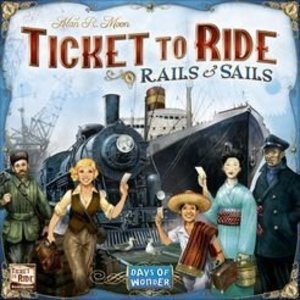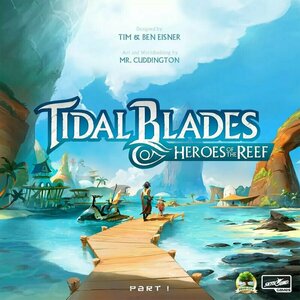
Truth Be Told
Tabletop Game
Truth Be Told is a revealing laugh-out-loud, pretend to know your friends party game! Each round one...

Ticket to Ride: Rails & Sails
Tabletop Game
Ticket to Ride: Rails & Sails is a standalone game with a double-sided board, the largest used in...

Endangered Orphans of Condyle Cove
Tabletop Game
A deplorable tabletop game devoid of joy, hope, or humor; which, regrettably, is also far more...

Hippocrates
Tabletop Game
Travel back to Greece in 370 BCE on the island of Kos. Hippocrates has just passed away and that...

Space Kraken
Tabletop Game
Space Kraken is a Rogue-like Sci-Fi Dungeon Crawler for one Solo Player; the game also comes with an...
Purple Phoenix Games (2266 KP) rated Tidal Blades; Heroes of the Reef in Tabletop Games
Apr 20, 2021
DISCLAIMER: As this game is a giant and many reviewers are starting to tackle it using multiplayer rules, I decided I would talk about the differences between multiplayer and solo rules. This review is using the included Solo Mode rules.
Setup for the Solo Mode uses most of the setup rules for the multiplayer game with a few exceptions. In the Solo Mode the player will have one character to control and one Rival to beat. The Rival will need their player board and standee or mini (I have the Deluxe Edition, so it’s minis in my case). In addition, the player will also choose two other characters to be Allies, utilizing their ability cards and minis. The Allies and Rival will be placed on the Champion board ahead of the player to begin the game. The player wins by having more points than the Rival at the end of the game.
Quickly, here is Tidal Blades in a nutshell. Players are attempting to gather the greatest standing on the Champion board (like a VP track) and VP from Challenge cards gained. The players earn these cards by using Actions to move to islands, gather resources, fight monsters, perform boating maneuvers and tricks, and can increase the potential for each of these by upgrading their central board dials. Shells and Fruit are common resources, and each player starts with two Actions per turn. The game lasts four total Days (or phases with several turns in each), and players earn more Action discs on Day two and four. Every time the dice are rolled to complete Challenges a Danger Die is also rolled and can wound the player by forcing a discard of dice. Each Day players can refresh and upgrade used dice to better their skill and concentrate their abilities. After Day four the game ends and players count up points to declare a victor!
Here is how gameplay is slightly different from the multiplayer experience. The Rival always goes first. They will also have one more Action disc to use on their turn (unfair, right?). When they begin their turn, a Challenge card is drawn. Whichever Island is featured on the card is to where the Rival will travel. Once arrived, the amount of VP awarded on the card is how many spaces from the top of the Island the Rival will be placed. Depending upon which Island the Rival ends the Challenge card will then be placed under the Solo Mode mat and a special action taken. The special actions could be revealing and resolving a Plot card in Droska Ring (special to Solo Mode), removing Monster hits from the Fold in the Chronosseum, or moving the boat in Lamara Stadium. The Judge location also plays a role in special actions should the Rival land on the same Island as they are. Other special goodies await, but I will leave you to discover those.
On the player’s turn, if the player is tied with or ahead of their Allies on the Champion board, the player will be able to use the Allies on their turn. This is handled similar to having an extra Action disc on the player’s turn. Send the Ally to a location and reap the rewards. Otherwise, for the player, turns are the same.
Components. Let me tell you: if you have the extra money to splurge for the Deluxe Edition, DO IT. The minis are amazing, the plastic shells are awesome, and those squishy fruit are so perfect! Obviously the game is perfectly playable and enjoyable with the basic components, but the improved bits are really something special. The cardboard everything is great, the GameTrayz inserts are incredible, and the art and colors are simply magical. I cannot say enough excellent things about what comes in this massive box. Druid City Games and Skybound Tabletop got everything right with this one.
It should be no surprise that I am in love with this game. Yes, it’s a Solo Chronicles, and I played by myself. I get that. Eventually I will be able to play this with others and by then I will be so engrossed in the lore that I will have no problems hyping up my playmates. Tidal Blades is an absolutely gorgeous game with so much going on that I don’t think I will ever tire of it. The game lasts four days but I wish it were a month because I just want to keep playing! The decisions to be made are all wonderfully delicious and there always seems to be too few on your turn. Yes, I know that sounds like all worker placement games, but it is especially true here. Almost every spot on the board gives immediate benefits that can be used, so even when a location is occupied, there will always be another of equal importance to your character. It’s so good.
Like I said before, I love the art and colors used. This is a stunner of a game on the table. It does take up quite a bit of room, especially if you use the arena dice tray (which I didn’t because I play at night when the kids are asleep and a hard plastic dice tray wakes up children). I count myself lucky to have the Deluxe Edition as well because those upgraded bits really make the game feel deluxe and fancy.
The Solo Mode is very good, and at least for me, very difficult to win. The combination I used for this review was playing as Axl against my Rival Caiman. Obviously switching out characters and using different Allies will change up the feel a bit, and I really cannot wait to try out all the permutations. When a game begs you to play it as often as you can and you look at it lovingly on your shelf, you know you have a Top 10 game, and a treasure in your collection.
Chris Sawin (602 KP) rated Ready Player One (2018) in Movies
Jun 18, 2019 (Updated Jun 18, 2019)
James Halliday (Mark Rylance), creator of the OASIS, dies suddenly but he leaves behind a treasure hunt for three keys hidden within the depths of the OASIS with the main prize being an Easter egg that would allow the winner to have complete control over the entirety of the OASIS. Wade (as his avatar Parzival) intends to win Halliday’s challenge to get out of The Stacks and adopts the title of Gunter (egg hunter) along with his friends Aech (Lena Waithe), Art3mis (Olivia Cooke), and brothers Daito (Win Morisaki) and Sho (Philip Zhao) who become known together as the, “HIgh Five,” but a video game conglomerate known as Innovative Online Industries or IOI spends all of their time and money attempting to find the secrets Halliday has hidden. IOI consists of an army known as the Sixers, which are players who owe large debts to the OASIS. CEO of IOI Nolan Sorrento (Ben Mendelsohn) intends to take the free-to-use OASIS and transform it into a monetized monopoly.
The storyline of Spielberg’s Ready Player One reminds me of the 19th episode of season two of Regular Show entitled, “High Score.” In that episode, Mordecai and Rigby attempt to beat the world record on a video game with record holder Garrett Bobby Ferguson (GBF or Giant Bearded Face). Ready Player One kind of expands on that concept and throws in a ton of nostalgic movie references while being set in the future. The weird thing is that those recycled moments that call back to the movies of yesteryear are the highlights of Ready Player One while the rest of the film suffers from Spielberg’s usual shortcomings.
I haven’t enjoyed a Steven Spielberg film since 2011’s The Adventures of Tintin. That combined with the trailer coming off as less than impressive and poster art from the marketing campaign (the main poster illustrated by Drew Struzan is amazing) that seemed to rely on generic face swapping via Photoshop on well-known movie posters had me really underwhelmed for the film overall. The film itself also suffers from corny dialogue, tender and romantic moments feeling force fed and overwhelming, and head-scratching sequences that leave you wondering why they needed to be included in the first place (the whole dance club/second challenge scene, for starters).
However, what the science fiction adventure gets right is the reason why you go to the movies. Spielberg along with cinematographer and frequent collaborator Janusz Kaminski know how to smoothly and effectively capture dynamic shots with a camera. When we first see Wade in The Stacks, he slides down a series of ropes and poles passing by and through various homes and junkyard cars that no longer run all while showcasing how plugged into a false reality civilization has become. The first race sequence of the film is also extraordinary with its fast pace and hectic action that is fairly easy to digest due to the sleek camera work. There’s a fairly lengthy segment devoted to a beloved horror film that is legitimately fantastic since it is not only a throwback to that original film, but it’s also injected with new thrilling terrors that you won’t see coming. Most battle sequences in the film with large ensembles are impressive for all of the obvious reasons; solid special effects, mass number of characters on the screen, a delicious dose of destruction, and most of all a countless series of references to movies, video games, and cartoons that you probably love. Witnessing what characters will pop up, when, and how they’ll be utilized is half of what makes Ready Player One so fun; it’s like a big budget version of South Park’s Imaginationland.
You either love or hate what Steven Spielberg has accomplished as a filmmaker, but it’s difficult not to admit that Ready Player One is a hell of a lot of fun even if you have some issues with the film. Spielberg has this cliche quality to him that is completely overbearing at times and he isn’t able to escape that aspect of his filmmaking with Ready Player One, but there’s enough of an entertaining and nostalgic value combined with not knowing who’s going to pop up next and some incredible cinematography highlighted by fluid yet flashy special effects resulting in a film that will be exciting and fun for anyone who was ever or still is a rabid gamer or movie lover. Spielberg has crafted a surefire crowd-pleaser that is basically a two and a half hour sentimental plunge directly into your childhood.
Purple Phoenix Games (2266 KP) rated Houses of Knowledge in Tabletop Games
Mar 26, 2020 (Updated Mar 26, 2020)
Houses of Knowledge pits 2-4 players against each other as museum curators desperately trying to fill their museums with interesting rooms and curious artifacts. In fact, a curator can end the competition once they are able to display eight lovely pieces in their halls. Beware, however, as the competition is also trying to gather the best gallery and may even attempt to pilfer your displayed items!
DISCLAIMER: We were provided a prototype copy of this game for the purposes of this review. These are preview copy components, but the final components will be exactly the same as these shown, if the pending Kickstarter campaign is successful. Also, it is not my intention to detail every rule in the game, but to give our readers a general feel for how the game plays. You can back the game through the Kickstarter campaign, order from your FLGS, or purchase through any retailers stocking it after fulfillment. -T
Setting up a game of Houses of Knowledge is quite a feat, as different decks need to be assembled according to player count. Refer to the rules to setup each deck. Once the decks are prepared and starting cards dealt to each player, create the Items and Actions markets by revealing six cards from each deck and assigning cost discs in decending order from the draw decks. Furthest away from the two draw decks will be placed the deck of Room cards, with two visible and available for purchase. These rooms will receive the leftover 5-value cost disc. Set the monicash aside to be used as a central bank. Determine the starting player and you are ready to begin!
Luckily, the game furnishes the players with reference cards so that all players have access to all options they are afforded on their turns. The first thing that happens on a turn is collecting income. Each turn a player earns 3 monicash (MC) plus the amounts earned from Rooms in their tableau. From here a turn has several options: buying Items or Actions from the market to your hand, paying 2 MC to play a card from your hand to your tableau, selling two cards for 2 MC, and buying Room cards.
When a player buys an Item or Action card from the market the new card is taken in hand, paying the cost shown on the cost disc either above or below the card taken. To play a card from hand, the player pays 2 MC to the bank and places an Item onto a corresponding Room card, or plays an Action card either on their own tableau or against an opponent.
Play continues in this fashion until one player is displaying eight Items in their Rooms or the draw decks are depleted. The round finishes completely so all players have an equal amount of turns, and then points are tallied and summed to determine the greatest curator and winner of Houses of Knowledge!
Components. As I mentioned in my disclaimer, we were provided a copy of this game for this preview. All components we were provided are finalized, so everything you see pictured here is how it will be upon a successful Kickstarter campaign. That said, the components are fantastic! The cards are good quality, the cost discs are good cardboard chips, and the money is the faux-paper money we are starting to see in games nowadays – and thank heavens for that! No more cheap Monopoly money! Oh by the way, the art on this one is superb and very chic. I love it!
So the game looks and feels great, but does it play well? YES. This one is excellent! At first it feels too simple because it is relatively easy to collect Rooms and Items to fit on those Rooms, so you think, “Heck, I can get eight Items in like four rounds!” That is, until your opponents hit you with some of the Action cards they’ve been hoarding unseen by you. One “friend” maybe steals one of your Items because you neglected to assign Guards to it, or the “pal” just before you in initiative order rearranges the Item cards so that the ones you wanted are now much more expensive, thus throwing your carefully-planned tactics down the drain. Ooh, it’s great tension! My one gripe: I wish it was longer so that I could really stick it to my enem- uhh, friends.
If you are a fan of card games that pack more of a punch than it first seems, and games that keep you wanting more, whilst giving you a grand feeling of quirky opulence, then you should certainly check out Houses of Knowledge. We are happy to recommend this one. Go back it on Kickstarter when the campaign begins!
Purple Phoenix Games (2266 KP) rated ICECOOL in Tabletop Games
Jun 25, 2019 (Updated Aug 13, 2020)
You and your Penguin buddies are so hungry that you decide to skip out on class early to go grab some snacks. But you’ve forgotten about the Hall Monitor! Their mission is to catch any unauthorized hall wanderers and send them back to class. Can you outmaneuver the Hall Monitor, or will you be caught and forced to go hungry until the end of class?
Disclaimer: I do not intend to rehash the rulebook in its entirety in this review, but rather provide a general overview of the rules and gameplay. To read the rules more in-depth, grab a copy of the game from your FLGS! -L
ICECOOL is a dexterity game in which players are trying to amass the most points over a number of rounds. Here’s how a round plays out. Select one player to be the Hall Monitor (called the Catcher) for the first round, and place their Penguin pawn in the kitchen box. All other players, aka the Runners, take their 3 colored fish tokens and attach them to the three corresponding doorways, and begin with their Penguin pawns in the classroom box. As a Runner, your goal is to collect your 3 fish tokens from their doorways. How do you do that? Flick your Penguin through a fish doorway to collect your snack. Yes, you read that right – flick. In this game, all movement is achieved by literally flicking your pieces throughout the boxes. To collect a fish, you must pass through the corresponding doorway completely in one single flick. Each time you collect a fish, draw the top card from the fish deck and keep it hidden from your opponents. Your other goal? Avoid the Catcher. If at any point, your Penguin comes into contact with the Catcher, you must forfeit your Hall Pass to the Catcher.
As the Catcher, your goal is to collect the Hall Pass of every other player. You achieve this goal by flicking your Penguin into any of the Runners. Turn order is as follows: Runners-Catcher, Runners-Catcher, etc., until the end of the round is triggered. The round is over when the Catcher has collected Hall Passes from every other player, or any Runner has collected all 3 of their fish. At the end of the round, each player collects 1 fish card per Hall Pass in their possession. So if you were caught by the Catcher, you’re outta luck! For the next round a new player is selected to be the Catcher, and play continues as above. The game ends once every player has taken a turn as the Catcher. Count up the points from your collected fish cards, and the player with the most points wins!
So a game of flicking Penguins around some boxes – sounds pretty simple, right? Yes and no. ICECOOL admittedly does not really require any serious strategy. Yes, you are trying to collect all 3 of your fish, but you’re mainly playing keep-away from the Catcher. And as the Catcher, you’re “It” in this quasi-game of Tag. So strategic, this is not. On the other hand, mastering the art of flicking your Penguin is a long and arduous process. Ok, it’s not arduous, but it is tricky to master! ICECOOL really puts your dexterity to the test to see if you have the proper form and control to move your Penguin to exactly where you want it to go. Half of the fun of this game is all the whiffed flicks and the comically accidental misdirections. The rulebook offers some flicking techniques to try out before your first game, and they are actually pretty helpful. I’ve not yet been able to achieve the jumping flick, but maybe one day I will rise to that level.
One other super neat thing about ICECOOL is the game setup. You’re playing with boxes of varying sizes. But here’s the kicker: they all nest into each other!!! So for storing, it looks like you just have one box. But in reality, there are 4 other boxes hidden inside. This concept is not one I’ve seen before in any other game, so that just makes ICECOOL a little bit more unique and interesting for me. Since I’m talking about the boxes, let me touch on components. The boxes are all of great quality, and are sturdy enough to hold up to clashing penguins. The Penguins themselves are good solid plastic, and I know they will last forever. Be careful though, flicking too hard might hurt your fingers! The deck of fish cards are a standard card quality. The artwork of the game is cute and thematic, and overall it’s a fun, immersive experience.
ICECOOL is not a game that I pull off the shelf at every game night. But it is one that is light enough, and entertaining enough, that it certainly gets a good amount of gameplay from my collection. Whether you are using it as a nice, short filler game, or you’re playing with some young’uns, it makes for a happy atmosphere full of energy and happiness. And that’s why Purple Phoenix Games gives ICECOOL a brrrrrrrrrilliant 18 / 24.




